Robert Douglas McIntyre was a Scottish physician and a Scottish National Party politician and Member of Parliament.

Greenwich Hospital was a permanent home for retired sailors of the Royal Navy, which operated from 1692 to 1869. Its buildings, in Greenwich, London, were later used by the Royal Naval College, Greenwich and the University of Greenwich, and are now known as the Old Royal Naval College. The word "hospital" was used in its original sense of a place providing hospitality for those in need of it, and did not refer to medical care, although the buildings included an infirmary which, after Greenwich Hospital closed, operated as Dreadnought Seaman's Hospital until 1986.

The London Lock Hospital was the first voluntary venereal disease clinic and the most famous and first of the Lock Hospitals which were developed for the treatment of syphilis following the end of the use of lazar hospitals, as leprosy declined. The hospital later developed maternity and gynaecology services before being incorporated into the National Health Service in 1948 and closing in 1952.
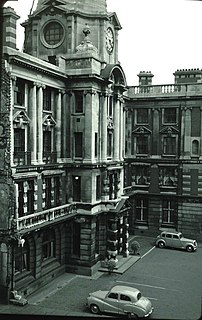
Manchester Royal Infirmary is a hospital in Manchester, England, founded by Charles White in 1752. It is now part of Manchester University NHS Foundation Trust, sharing buildings and facilities with several other hospitals.

The Royal Infirmary of Edinburgh, or RIE, often known as the Edinburgh Royal Infirmary, or ERI, was established in 1729 and is the oldest voluntary hospital in Scotland. The new buildings of 1879 were claimed to be the largest voluntary hospital in the United Kingdom, and later on, the Empire. The hospital moved to a new 900 bed site in 2003 in Little France. It is the site of clinical medicine teaching as well as a teaching hospital for the University of Edinburgh Medical School. In 1960, the first successful kidney transplant performed in the UK was at this hospital. In 1964, the world's first coronary care unit was established at the hospital. It is the only site for liver, pancreas and pancreatic islet cell transplantation and one of two sites for kidney transplantation in Scotland. In 2012 the Emergency Department had 113,000 patient attendances, the highest number in Scotland. It is managed by NHS Lothian.
Isaac Maddox was an Anglican clergyman, successively bishop of St Asaph and of Worcester. He was a member of the Royal Society.

Hull Royal Infirmary is a tertiary teaching hospital and is one of the two main hospitals for Kingston upon Hull. It is situated on Anlaby Road, just outside the city centre, and is run by Hull University Teaching Hospitals NHS Trust.

The Northern General Hospital is a large teaching hospital and Major Trauma Centre in Sheffield, England. Its departments include Accident and Emergency for adults, with children being treated at the Sheffield Children's Hospital on Western Bank. The hospital is managed by the Sheffield Teaching Hospitals NHS Foundation Trust.

The Derbyshire Royal Infirmary was a hospital in Derby that was managed by the Derby Teaching Hospitals NHS Foundation Trust. Following the transfer of community services to the London Road Community Hospital located further south-east along London Road, the infirmary closed in 2009 and most of the buildings were demolished in spring 2015.

St Mark's Hospital is a hospital in Harrow, Greater London, England. Managed by London North West University Healthcare NHS Trust, it is the only hospital in the world to specialise entirely in intestinal and colorectal medicine and is a national and international referral centre for intestinal and colorectal disorders. It is the only hospital in the UK, and one of only 14 worldwide, to be recognised as a centre of excellence by the World Organisation of Digestive Endoscopy.
Several hospitals and former hospitals are known formally or informally as Royal Hospital or simply The Royal, indicating some form of royal patronage, such as sponsorship, usage, or creation by royal charter.
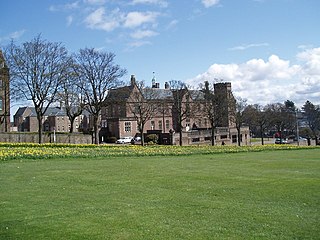
Dundee Royal Infirmary, often shortened to DRI, was a major teaching hospital in Dundee, Scotland. Until the opening of Ninewells Hospital in 1974, Dundee Royal Infirmary was Dundee's main hospital. It was closed in 1998, after 200 years of operation.

Sir Jonathan Wathen Waller, 1st Baronet, GCH, was an English eye surgeon, who practiced in London during the latter part of Georgian era. He was the eye doctor of King George III of England and his son William IV. He also attended the death of George IV.
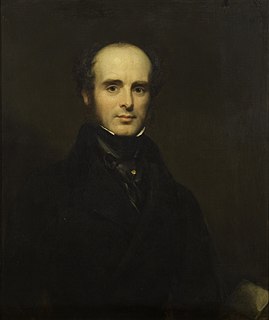
James Hope (1801–1841) was an English physician. He has been called "the first cardiologist in the modern sense". He is known for discovering the early diastolic murmur of mitral stenosis in 1829.
Sir Charles Scudamore (1779–1849) was an English physician, known for his writings on gout.

Monsall Hospital was a hospital in North Manchester, England.
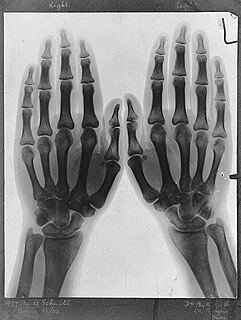
Norah Henriette Schuster FRCPath was a British pathologist and the first woman to take the pre-clinical medical course at the University of Cambridge. She was the first woman to be appointed as a doctor at the Manchester Royal Infirmary and, in 1950, the first female president of the Association of Clinical Pathologists.

Isaac Buxton was an English physician who specialised in the treatment of asthma, consumption and other pulmonary diseases. In 1814 he founded an eight-bed infirmary that became the Royal Chest Hospital.
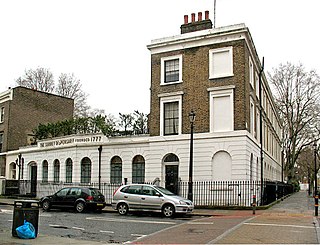
The Surrey Dispensary was founded in 1777 to administer advice and medicine to the poor of the Borough of Southwark and places adjacent. It was once one of the largest dispensaries in south London.
















